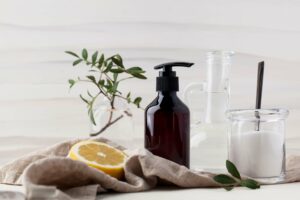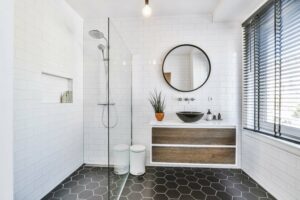
Spring is the season of renewal, making it the perfect time to refresh and revitalise your home with spring cleaning. As a cleaning company that prioritises green cleaning methods and products, we believe that a deep clean doesn’t need to come with harmful chemicals or environmental impact. With natural, eco-friendly solutions, you can achieve a sparkling clean home while protecting your and your family’s health, and our planet.
In this guide, we share step-by-step tips for spring cleaning your home the green way. That means using non-toxic products and sustainable methods to create a healthier living environment.
Before you begin spring cleaning, take time to declutter each room. Sort through items you no longer use and decide whether they can be donated, recycled or repurposed. A clutter-free space is easier to clean and helps create a more serene and functional living environment.
Eco-Friendly Tip: Donate gently used items to local charities instead of throwing them away. This helps reduce waste and supports sustainability.

Swap out chemical-laden cleaning products for natural alternatives when you are spring cleaning. Natural cleaning products are just as effective and much safer for you, your family and the environment. Ingredients such as vinegar, baking soda, lemon juice and essential oils can handle most of your cleaning needs.
Eco-Friendly Tip: Make your own multipurpose cleaner by mixing equal parts water and vinegar, then add a few drops of your favourite essential oil for a pleasant scent.
Instead of using harsh carpet shampoos or sprays, freshen your carpets and upholstery with baking soda. Sprinkle baking soda over the surface, let it sit for 15 to 30 minutes to absorb any odours, then vacuum thoroughly. You can also add a few drops of your favourite essential oil for a natural, fresh scent. For more tips on carpets, you may like to read our article, A Guide to Maintaining Carpets.
Eco-Friendly Tip: Regular vacuuming helps reduce allergens like dust and pet hair. Be sure to use a vacuum with a HEPA filter to capture smaller particles for better indoor air quality.

Instead of disposable cleaning products, choose reusable tools such as microfiber cloths, washable mop heads and natural sponges. These tools are not only more environmentally friendly but also often more effective at trapping dust and dirt.
Eco-Friendly Tip: Microfiber cloths can be washed and reused hundreds of times, making them a sustainable alternative to paper towels. They also require fewer cleaning products to work effectively.
One of the simplest ways to refresh your home is to let in some fresh air while you are spring cleaning. Open windows and doors to circulate the air and reduce indoor pollutants. This is especially important during and after cleaning, as it helps clear away any lingering dust or odours.
Eco-Friendly Tip: Houseplants like aloe vera, spider plants and peace lilies are natural air purifiers. Add a few green plants to your indoor spaces to help keep the air clean and fresh all year long.
The kitchen is often a hub of activity, and spring is the perfect time to give it a thorough, eco-friendly clean. Use a vinegar and water solution to wipe down countertops, cabinet doors and appliances. For baked-on grime in your oven, sprinkle baking soda on the surface, spray with water, and let it sit overnight before wiping clean. For more natural oven cleaning tips, read our article Oven Cleaning Without the Toxic Chemicals.
Eco-Friendly Tip: Avoid using single-use plastic or paper towels. Instead, invest in washable, reusable microfibre cloths for kitchen cleaning. Not only are they better for the environment, but they’re also more cost-effective in the long run.
Spring cleaning your bathroom doesn’t require harsh chemicals. In fact, you can use a mixture of vinegar and baking soda to scrub away soap scum and grime from sinks, bathtubs and tiles. For a sparkling toilet, pour a cup of vinegar into the bowl and let it sit for 10 to 15 minutes before scrubbing.
Eco-Friendly Tip: To prevent mould in your bathroom, ensure proper ventilation by using exhaust fans or opening a window during and after showers. Wiping down surfaces with a microfiber cloth also helps reduce moisture buildup. You might also like to read How to Treat Mould Naturally.

Spring cleaning is a great opportunity to focus on reducing household waste. Instead of tossing old items, consider upcycling them or finding eco-friendly disposal methods. For example, old t-shirts can be turned into rags and glass jars can be repurposed for storage.
Eco-Friendly Tip: When buying new cleaning supplies, look for products with minimal packaging or opt for refills to reduce plastic waste.
Spring cleaning is about more than just making your home look great… it’s also about creating a healthy and happy living environment. By embracing green cleaning methods, you can ensure your home is free from toxic chemicals, while also minimising your impact on the planet. With a few simple swaps and eco-friendly practices, your spring cleaning routine will leave your home sparkling, naturally. Click here to access our Room by Room Spring Cleaning Checklist.
If you struggle to find the time to clean your home regularly or give it a once-off spring clean, enquire here. The Bliss Home Care Services team are dedicated to keeping your home clean and healthy with our detailed spring cleaning service.
 At Bliss Home Care Services we are all for finding natural and sustainable ways to make our world and our environment a safer and healthier place to live. One place to start is to make small changes in our home and everyday life. This blog is dedicated to eliminating cling wrap which is harmful to human health and ends up in landfill and in our oceans. We’re going to share how easy it is to make your own reusable bees wax wraps to replace cling wrap.
At Bliss Home Care Services we are all for finding natural and sustainable ways to make our world and our environment a safer and healthier place to live. One place to start is to make small changes in our home and everyday life. This blog is dedicated to eliminating cling wrap which is harmful to human health and ends up in landfill and in our oceans. We’re going to share how easy it is to make your own reusable bees wax wraps to replace cling wrap.
Bees wax wraps are a safe and healthy alternative to cling wrap and the best part is that it will reduce the waste each home is producing. According to the most recent statistics from National Waste Report, Australia as a nation produces 64 million tons per year. That equates to approx. 2.7 tonnes of waste every year – that’s right 2.7 tonnes of waste in 365 days! Let’s say no to cling wrap and reducing waste.
Why Is Cling Wrap So Bad?
All plastic products are made up of chemicals and there have been many reports and findings over the years that these chemicals seep into our food and drinks and eventually cause many harmful health concerns.
It’s also a non-recyclable product and ends up in landfill or litter in our streets and eventually finds its way into our beautiful oceans, affecting our environment, wildlife and sea life.
What Is A Safe Alternative?
Firstly, say no to cling wrap and replace it with a safer and healthier alternative – bees wax wraps which are reusable and incredibly easy to make at home.
Given that it’s the beginning of the school holidays here in Melbourne, Australia making your own bees wax wraps to replace cling wrap is a great activity to get the kids involved in. They can make their own colourful, bright and reusable bees wax wraps that the whole family can use in 4 easy steps. All you need are 6 items and you have a whole lot of fun ahead of you!
What You Will Need
Step 1
Preheat oven to 180 degrees Celsius. Place your bees wax bar in an oven proof container and insert into the oven until it’s completed melted. This normally only takes 5-10 minutes. Do not use a microwave to melt the bees wax.
Step 2
Place an old towel or blanket on a flat surface to protect your surface. Cut out squares or circles from your sheets of baking paper and cotton fabric.
You can make a variety of sizes to suit different sized bowls and for sandwiches. Ensure you cut the baking paper a little larger than the fabric for any overflow and drizzles.
Step 3
Dip your brush into the melted wax and paint it onto the fabric squares with a small clean brush or pastry brush. Start at the top and work your way to the bottom to ensure a smooth and even coverage.
Just a small amount of the wax is sufficient, don’t use too much wax on the fabric as this will cause it to crack. Turn the fabric over gently and repeat on the other side.
If you’ve used a thin fabric, the melted bees wax may have seeped through to the other side to coat the entire fabric.
Repeat this process until you’ve used all the beeswax and fabric.
Step 4
Once both sides of the fabric has been evenly coated and you’re happy with the bees wax wrap, lift the corners from the baking paper gently and hang it to dry.
And there you go, you have made your very own bees wax wraps! Just remember that they are not air-tight so we do recommend using them to cover foods that will be eaten within a day such as sandwiches, a bowl of food or fruit. It is not recommended to use them on perishable items such as fresh meat, fish or poultry.
You can simply maintain your beeswax wrap by rinsing them clean after use with cold water and mild soap. If you used hot water it would melt the wax. Air dry the wrap on your dish rack or on a towel on a flat surface. They can be reused time and time again.
Help to spread the word on how easy it is to make small changes to make a big difference. You may also be interested in reading our article Reduce Waste at Home where we share our top five ideas to inspire you to make more changes to your daily habits and further reduce waste at home.
The revolutionary environmentally friendly cleaning product is based on Bio-bacterial technology. It consists of billions of friendly bacteria that target and digest organic matter eliminating the source of cleaning problems rather than masking them.
Enzyme and bacteria cleaning products or in are composed of living bacteria and or enzymes that break down and softens organic soils like fat, proteins, carbohydrates and grease, while simultaneously eliminating bad odours.
Enzyme and bacteria cleaning products present an alternative to harsher chemical solutions, like solvents and strong acids or alkalis. They are more user-friendly than products with extreme pH.
The process by which enzyme and bacteria cleaners work is important to understand. When a bacteria product is applied, the microorganisms, which have been dormant, begin to grow and digest the waste that is present and is used as their food source; and the bacteria in turn multiply.
Since bacteria does not have a mouth, they breakdown and metabolize waste by producing enzymes. The waste that has been broken down is now small enough to be absorbed through the bacteria cell wall. Once the waste particles are inside the cell they can be broken down and used as a fuel and energy source, allowing the cell to reproduce again and again, thus repeating the process. As long as organic soils are available as a food source the process will continue.
Straight enzyme cleaners are products that contain only the enzymes, which have been separated from the bacteria that produce them. These products also breakdown soils like grease, starches, and proteins. Once the enzymes have done their job, they are used up and cannot reproduce themselves; in turn they will not be able to degrade any more waste.
This process guaranties natural way to treat common cleaning problems with no need for harsh chemical cleaners, making cleaning process simpler, healthier and environmentally friendly cleaning.
Until recently and even at present time, most cleaning companies cleaned for appearance which is what their clients were looking for. However, more and more home owners are concerned with the chemicals that are used in their homes and are looking for better alternatives. Green cleaning is not only cost effective, but it is better for a home’s indoor air quality and making it better environment for families.
But with so many products on the market these days, how do you know which ones are truly "Green"? Here are some suggestions on what to look for when choosing green cleaning products:
Once you've decided to make the switch to green cleaning products, use this as your guide for making the right choices.
Microfiber is no longer a "buzz word" that is taking the cleaning world by storm. Most cleaning companies should be using them on a daily basis as a basic cleaning tool.
How to choose the right microfiber cloth for your all cleaning needs. There are different grades of Microfiber for different types of tasks and most manufactures will carry at least 3 different types of Microfiber cloths. The most common types are:
When purchasing for your Microfiber cloths, visit your local cleaning suppliers, as they more likely to supply high quality Microfiber cloths. You can usually tell a good quality Microfiber cloth by doing couple of tests. First, run the cloth across your hand. Does it seem to catch? This is caused by the dense fibers and indicates quality Microfiber. Next, put a small amount of hand lotion on mirror and then wipe your mirror cloth to see how many passes it takes to remove the lotion. A good quality Microfiber cloth will remove the lotion in only one or two passes.
Microfiber cloths come in variety of colours and the reason for that to prevent cross contamination. You certainly would not want to use to clean a toilet and then use the same cloth to clean your kitchen bench tops.
when washing microfiber cloths, it is best to wash and dry them separately from other laundry items such as cotton cloths, towels or clothing. If you don't wash them separately, they will pull the lint off these items and become so loaded it may make them useless. Avoid using bleach and fabric softener. Bleach will damage the fibers and fabric softener will reduce the static charge, which is an important part of what makes Microfiber cloth works so well.
when cleaning Microfiber, use about half the amount of laundry detergent you would normally use for a load of laundry. Microfibers release soil very easily when washed, so more is not better in this case. It is recommended that your water temperature not to exceed 95 Celsius. Microfibers can air dry (Microfiber cloths dry very quickly) or you can use a machine to dry them as long as you use a low heat setting and do not add a fabric softener sheet.
Green cleaning is much more than using few chemicals labeled as GREEN. Green cleaning is defined as a system of cleaning promotes healthy surroundings for children, families, visitors and pets that we love. It is equally important and detrimental to environment that we live and share.
We are becoming more concerned and aware about the health of the environment. Awareness is also growing about importance of air quality.
Did you know that the air in our home can be more toxic than the air outside....
The air inside your home can be two to five times more polluted than the air outside. If you are not regularly airing your home (allowing fresh air to enter) will have stale, stagnant and filled with chemical pollutants. Poor air quality in your home can lead to health problems such as allergies, respiratory problems, eye irritation and tiredness.
We are also constantly adding to the air pollution in our home with products we use such as hair spray, deodorants, perfumes, cleaning products, pesticides etc. and we are constantly breathing this polluted air in our homes. The air in the home is not moving around and refreshed by winds and renewed by plants. Pollutants and soil is brought in all the time with our shoes. Cleaning is an important part of removing dirt and pollutants from your home and allowing fresh air to flow in pushing stale air out will create healthy breathing for you and your family.
It has been, and still is a traditional practice, in many countries to air out the blankets and rugs on a daily cleaning ritual. This would remove dirt and toxic spores and the sun light would kill and re-freshen bed coverings and rugs. These days houses are sealed, covered to avoid nastier from coming in but what we are doing is trapping pollution from the outside and concentrating the fumes from hundreds of products we use inside in our homes (air fresheners, deodorants, insecticides, cleaning products) which can lead to toxic indoor atmospheres.
How a home is cleaned can be a major factor in the quality of indoor air. It is important to eliminate individual sources of pollution or reduce their emissions. A simple practice is to OPEN THE WINDOWS on a regular basis to let fresh air in and help move the stale stagnated air to move around. Good practice to air your home on a regular basis, especial your bedroom after you have woken up let some fresh air in. When cleaning your home open the doors and windows.
Another is to use non-toxic and eco-friendly cleaning products in your home.